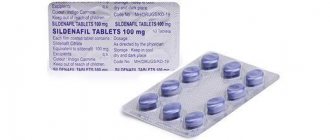Sildenafil Vertex, 100 mg, film-coated tablets, 1 pc.
The influence of other drugs on the pharmacokinetics of sildenafil
The metabolism of sildenafil occurs mainly in the liver under the influence of cytochrome isoenzymes CYP3A4 (the main pathway) and CYP2C9, therefore inhibitors of these isoenzymes can reduce the clearance of sildenafil, and inducers, accordingly, increase the clearance of sildenafil. A decrease in the clearance of sildenafil was noted with simultaneous use of inhibitors of the cytochrome CYP3A4 isoenzyme (ketoconazole, erythromycin, cimetidine). Cimetidine (800 mg), a nonspecific inhibitor of the cytochrome CYP3A4 isoenzyme, when taken together with sildenafil (50 mg), causes an increase in plasma sildenafil concentrations by 56%.
A single dose of 100 mg of sildenafil together with erythromycin (500 mg/day 2 times a day for 5 days), a specific inhibitor of the cytochrome CYP3A4 isoenzyme, while achieving a constant concentration of erythromycin in the blood, leads to an increase in the AUC of sildenafil by 182%.
When co-administered with sildenafil (100 mg once) and saquinavir (1200 mg/day 3 times a day), an inhibitor of HIV protease and the cytochrome CYP3A4 isoenzyme, while achieving a constant concentration of saquinavir in the blood, the Cmax of sildenafil increased by 140%, and the AUC increased by 210%. Sildenafil has no effect on the pharmacokinetics of saquinavir. Stronger inhibitors of the cytochrome CYP3A4 isoenzyme, such as ketoconazole and itraconazole, may cause more severe changes in the pharmacokinetics of sildenafil.
The simultaneous use of sildenafil (100 mg once) and ritonavir (500 mg 2 times a day), an HIV protease inhibitor and a strong cytochrome P450 inhibitor, while achieving a constant concentration of ritonavir in the blood leads to an increase in sildenafil Cmax by 300% (4 times ), and AUC - by 1000% (11 times). After 24 hours, the concentration of sildenafil in the blood plasma is about 200 ng/ml (after a single use of sildenafil alone - 5 ng/ml).
Grapefruit juice, a weak inhibitor of CYP3A4, may moderately increase plasma concentrations of sildenafil.
If sildenafil is taken in recommended doses by patients simultaneously receiving strong inhibitors of the cytochrome CYP3A4 isoenzyme, then the Cmax of free sildenafil does not exceed 200 nM, and the drug is well tolerated.
A single dose of an antacid (magnesium hydroxide/aluminum hydroxide) does not affect the bioavailability of sildenafil.
Inhibitors of the cytochrome CYP2C9 isoenzyme (such as tolbutamide, warfarin), the cytochrome CYP2D6 isoenzyme (such as selective serotonin reuptake inhibitors, tricyclic antidepressants), thiazide and thiazide-like diuretics, ACE inhibitors (angiotensin-converting enzyme) and calcium antagonists do not affect the pharmacokinetic parameters of sildenafil.
Azithromycin (500 mg/day for 3 days) has no effect on the AUC, Cmax, Tmax, elimination rate constant and T1/2 of sildenafil or its main circulating metabolite.
Nicorandil is a hybrid of a nitrate and a potassium channel activator. Due to the presence of a nitrate component, it may have serious interactions with sildenafil.
Effect of sildenafil on other drugs
Sildenafil is a weak inhibitor of cytochrome P450 isoenzymes 1A2, 2C9, 2C19, 2D6, 2E1 and 3A4 (IC50>150 µmol). When sildenafil is taken at recommended doses, its Cmax is approximately 1 µmol, so it is unlikely that sildenafil could affect the clearance of substrates of these isoenzymes.
Sildenafil enhances the hypotensive effect of nitrates both with long-term use of the latter and when they are prescribed for acute indications. In this regard, the use of sildenafil in combination with nitrates or nitric oxide donors is contraindicated.
When co-administering the alpha-blocker doxazosin (4 mg and 8 mg) and sildenafil (25 mg, 50 mg and 100 mg) in patients with benign prostatic hyperplasia with stable hemodynamics, the average additional reduction in systolic/diastolic blood pressure in the supine position was 7 /7 mmHg Art., 9/5 mm Hg. Art. and 8/4 mm Hg. Art. respectively, and in a standing position - 6/6 mm Hg. Art., 11/4 mm Hg. Art. and 4/5 mm Hg. Art. respectively. Rare cases of symptomatic postural hypotension, manifested in the form of dizziness (without fainting), have been reported in such patients. In selected sensitive patients receiving alpha-blockers, concomitant use of sildenafil may lead to symptomatic hypotension.
There were no signs of significant interaction between sildenafil (50 mg) and tolbutamide (250 mg) or warfarin (40 mg), which are metabolized by the cytochrome CYP2C9 isoenzyme.
Sildenafil (100 mg) does not affect the pharmacokinetics of HIV protease inhibitors, saquinavir and ritonavir, which are substrates of the cytochrome CYP3A4 isoenzyme, at constant blood levels.
Sildenafil (50 mg) does not cause an additional increase in bleeding time when taking acetylsalicylic acid (150 mg).
Sildenafil (50 mg) does not enhance the hypotensive effect of ethanol in healthy volunteers with a maximum ethanol concentration in the blood of an average of 0.08% (80 mg/dL).
In patients with arterial hypertension, no signs of interaction between sildenafil (100 mg) and amlodipine were detected. The average additional decrease in blood pressure in the supine position is 8 mm Hg. Art. (systolic) and 7 mm Hg. Art. (diastolic).
The use of sildenafil in combination with antihypertensive drugs does not lead to additional side effects.
Amlodipine Vertex Tablets, box, 60 pcs, 10 mg, for oral administration, for adults
Interaction with other drugs
Amlodipine can be safely used for the treatment of arterial hypertension together with thiazide diuretics, alpha-blockers, beta-blockers or ACE inhibitors.
In patients with stable angina, amlodipine can be combined with other antianginal agents, such as long- or short-acting nitrates and beta-blockers. Unlike other BMCCs, no clinically significant interaction with amlodipine (III generation BMCCs) was found when used together with non-steroidal anti-inflammatory drugs, including indomethacin.
It is possible to enhance the antianginal and antihypertensive effect of BMCC when used together with thiazide and loop diuretics, ACE inhibitors, beta-blockers and nitrates, as well as enhance their antihypertensive effect when used together with alpha-blockers and neuroleptics.
Although negative inotropic effects were not usually observed in studies of amlodipine, some BMCCs may enhance the negative inotropic effects of antiarrhythmic drugs that cause QT prolongation (for example, amiodarone and quinidine).
Amlodipine can also be safely used concomitantly with antibiotics and oral hypoglycemic agents.
Sildenafil
A single dose of 100 mg of sildenafil in patients with essential hypertension does not affect the pharmacokinetic parameters of amlodipine.
Atorvastatin
Repeated use of amlodipine at a dose of 10 mg and atorvastatin at a dose of 80 mg is not accompanied by significant changes in the pharmacokinetics of atorvastatin.
Simvastatin
Simultaneous repeated use of amlodipine at a dose of 10 mg and simvastatin at a dose of 80 mg leads to an increase in simvastatin exposure by 77%. In such cases, the dose of simvastatin should be limited to 20 mg.
Ethanol (drinks containing alcohol)
Amlodipine with single and repeated use in a dose of 10 mg does not affect the pharmacokinetics of ethanol.
Antivirals (ritonavir)
Ritonavir increases plasma concentrations of BMCC, including amlodipine.
Neuroleptics and isoflurane
They enhance the antihypertensive effect of dihydropyridine derivatives.
Calcium preparations
May reduce the effect of BMCC.
Lithium preparations
When BMCC is used together with lithium preparations (no data are available for amlodipine), their neurotoxicity may increase (nausea, vomiting, diarrhea, ataxia, tremor, tinnitus).
Cyclosporine
Studies of the simultaneous use of amlodipine and cyclosporine in healthy volunteers and all groups of patients with the exception of patients after kidney transplantation have not been conducted. Various studies of the interaction of amlodipine with cyclosporine in patients after kidney transplantation show that the use of this combination may not lead to any effect or increase the minimum concentration (Cmin) of cyclosporine to varying degrees, up to 40%. These data should be taken into account and cyclosporine concentrations should be monitored in this group of patients when cyclosporine and amlodipine are co-administered.
Digoxin
Amlodipine has no effect on the plasma concentration of digoxin and its renal clearance.
Warfarin
Does not significantly affect the effect of warfarin (prothrombin time).
Cimetidine
Cimetidine does not affect the pharmacokinetics of amlodipine.
In in vitro studies, amlodipine does not affect the plasma protein binding of digoxin, phenytoin, warfarin and indomethacin.
Grapefruit juice
A simultaneous single dose of 240 mg of grapefruit juice and 10 mg of amlodipine orally is not accompanied by a significant change in the pharmacokinetics of amlodipine. However, it is not recommended to use grapefruit juice and amlodipine at the same time, since genetic polymorphism of the CYP3A4 isoenzyme may increase the bioavailability of amlodipine and, as a result, enhance the antihypertensive effect.
Aluminum- or magnesium-containing antacids
A single dose does not have a significant effect on the pharmacokinetics of amlodipine.
CYP3A4 isoenzyme inhibitors
With the simultaneous use of diltiazem at a dose of 180 mg and amlodipine at a dose of 5 mg in elderly patients (from 69 to 87 years old) with arterial hypertension, an increase in the systemic exposure of amlodipine by 57% was observed. Concomitant use of amlodipine and erythromycin in healthy volunteers (18 to 43 years of age) does not lead to significant changes in amlodipine exposure (increase in area under the concentration-time curve (AUC) by 22%). Although the clinical significance of these effects is unclear, they may be more pronounced in elderly patients.
Potent inhibitors of the CYP3A4 isoenzyme (for example, ketoconazole and itraconazole) may increase the plasma concentration of amlodipine to a greater extent than diltiazem. Amlodipine and inhibitors of the CYP3A4 isoenzyme should be used with caution.
Clarithromycin (CYP3A4 inhibitor)
Patients taking clarithromycin and amlodipine at the same time have an increased risk of decreased blood pressure. Patients taking this combination are advised to be under close medical supervision.
Inducers of the CYP3A4 isoenzyme
There are no data on the effect of inducers of the CYP3A4 isoenzyme on the pharmacokinetics of amlodipine. Blood pressure should be carefully monitored while using amlodipine and inducers of the CYP3A4 isoenzyme.
Tacrolimus
When used simultaneously with amlodipine, there is a risk of increasing the concentration of tacrolimus in the blood plasma. In order to avoid toxicity of tacrolimus when used concomitantly with amlodipine, the concentration of tacrolimus in the blood plasma of patients should be monitored and the dose of tacrolimus should be adjusted if necessary.
Mammalian mechanistic target of rapamycin (mTOR) inhibitors
mTOR inhibitors such as sirolimus, temsirolimus and everolimus are substrates of the CYP3A isoenzyme. Amlodipine is a weak inhibitor of the CYP3A isoenzyme. When used concomitantly with mTOR inhibitors, amlodipine may increase their exposure.

